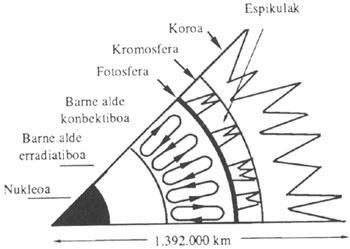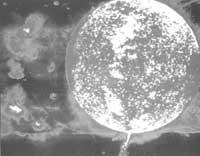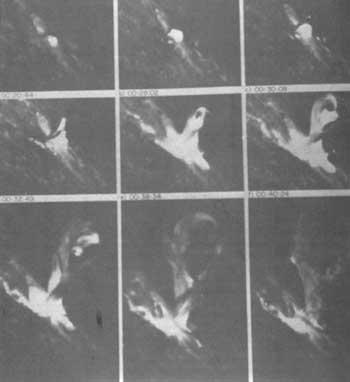Solar activity (I)
1989/04/01 Arregi Bengoa, Jesus Iturria: Elhuyar aldizkaria
Despite being the closest star to us, so far we have not talked about it. It is time, then, to speak of its peculiarities with the excuse of this intense activity that it has shown lately. On this occasion we will conduct a general analysis of the Sun and in the following we will delve into the most common manifestations of activity and its effects on the Earth and surrounding space.
As is known, from observations of the emissions of thousands of stars, scientists have been able to highlight the most important steps of their evolution. Since we can consider the Sun as a running star in terms of its size, temperature and other particularities, all of this knowledge is of great interest in detecting the more general aspects of his life (for example, that 4.6 billion years ago he was born and that he will live as much). But what will interest us, above all, will be phenomena that can be seen thanks to the proximity of the Sun and that have not yet found explanation within those main lines that we have mentioned.
The Earth is only 8.5 minutes from the Sun (149.600,000 km). Therefore, the processes generated on its surface can be visualized quite well. The most important are fables, blacks, protrusions and so-called eruptions or flashes. But, as we have said, we must first analyze the structure of the Sun and then be able to adequately explain all these phenomena.

Most of the solar sphere is opaque to radiation. Therefore, the interior is divided based on the little information that we can obtain through theoretical models. The outer part, known as the atmosphere of the Sun, is transparent and according to observations it appears divided into three layers: the photosphere, the chromosphere and the crown. In the image you can see the section of the Sun with its approximate dimensions. As for the mass, we can say that it is 332,946 times greater than that of the Earth, that is, 1,989,1030 g. The density is very different depending on the distance to the center, but the average value is 1.41 g/cm 3, four times lower than that of the Earth.
By converting hydrogen into helium in the solar nucleus thermonuclear reactions occur that characterize the stars and generate energy. The temperature is about 10 million degrees, a density of about 160 g/cm 3 and a pressure of about 10 11 atmospheres. As a result of the aforementioned processes, it emits spectral radiation and a high number of neutrinos. The latter can cross the Sun without any impediment and launch into space, but the elimination of energy released in the form of radiation finds much greater obstacles, which last about a million years.
Of course, the most abundant components of our star are hydrogen and helium with very low percentages of other heavier elements, although the combustion of helium will slightly increase the amount of other elements at the end of the Sun's life. It must be said, on the other hand, that most of the matter is in the plasma state, that is, like atoms that have lost one or more electrons (often all).

The interior is radiative and so it is called because the emission g that is generated in the nucleus is done by radiation processes, that is, the atoms present absorb the radiation to be reemitted back to another frequency. These interactions are repeated without interruption, as energy takes about a million years to travel the 500,000 km that separate the core from the end of this region. Next is the convective internal area, which extends to about 200,000 km.
The transport of energy is done by convection and the crossing takes place around a month. The layers above are transparent and from now on the light spreads without difficulty. Therefore, all the light that comes to us comes from the so-called atmosphere that warms the energy that has come out. What is under these layers is invisible, of course, because it does not emit light. But more specifically, the first layer we find is the photosphere, and as it is much denser than the others, its luminosity covers that of the others. That's why the photosphere is the only layer we see under normal conditions. It is estimated that its thickness is about 200 or 300 km and its base has an approximate temperature of 8000 K.
As in the previous parts, the temperature inside this layer decreases as we increase to reach 4000 degrees in the upper limit. Density also evolves similarly, being dependent on the function of the radius, and at this level it can be 8 orders lower than the gram per cubic centimeter. The lower part of the photosphere has a special structure, caused by the convective layer below it. It is formed by thin “rice grains” that give it a grainy appearance. These luminous specimens appear in places where convection currents emerge the lower hot matter, while the dark edges between them appear at the limits where matter cools and fades. The average size of the clumps is about 1000 km and are a consequence of a dynamic process, which causes a continuous change of shape.
The chromosphere is named for its reddish color, but as we have said before, under normal conditions the light of the photosphere covers it. Therefore, you can see only in total eclipses or with special instruments. The most visible formations in the structure of the chromosphere are the spicles. These are taper jets, shaped like a cone, that reach a height of 10,000 km, although matter falls to the Sun. Some believe that the blades extend above the chromosphere and consider that their width is only 3000 km. The density is so low that it does not occur in g/cm 3, but in fractions/cm 3. For example, at 2000 km from the top of the photosphere 13x10 9 fractions/cm 3.
Temperature, however, does not follow the same logical law as height and increases by the lower part of the chromosphere. Thus, at the 2000 km mentioned above the temperature approaches 105 K. However, these values are not homogeneous, since the conditions in the spicles or outside them can be different.

The crown, finally, is a flash that surrounds the Sun. It is very thin and consists mainly of thrown matter. Therefore, depending on the activity of the Sun can have very different shapes and dimensions. For the same reason we cannot consider it spherical and homogeneous.
The density decreases as the distance to the Sun increases, until it equals it with the interstellar dust, and the temperature, as already mentioned for the chromosphere, increases depending on the distance, until reaching 1,5x106 K to 100 million kilometers from the center.
This heating could cause a thermodynamic problem if an effective crown heating process was not found, as heat cannot continuously pass from a cold layer to a warmer one. The problem remains unsolved. It may be due to ionization processes, but it is still necessary to investigate along other lines.
To finish, and to get the idea of the violence of the processes that take place in the Sun, we will say: The solar emission power is 4x10 23 kW.

Gai honi buruzko eduki gehiago
Elhuyarrek garatutako teknologia





